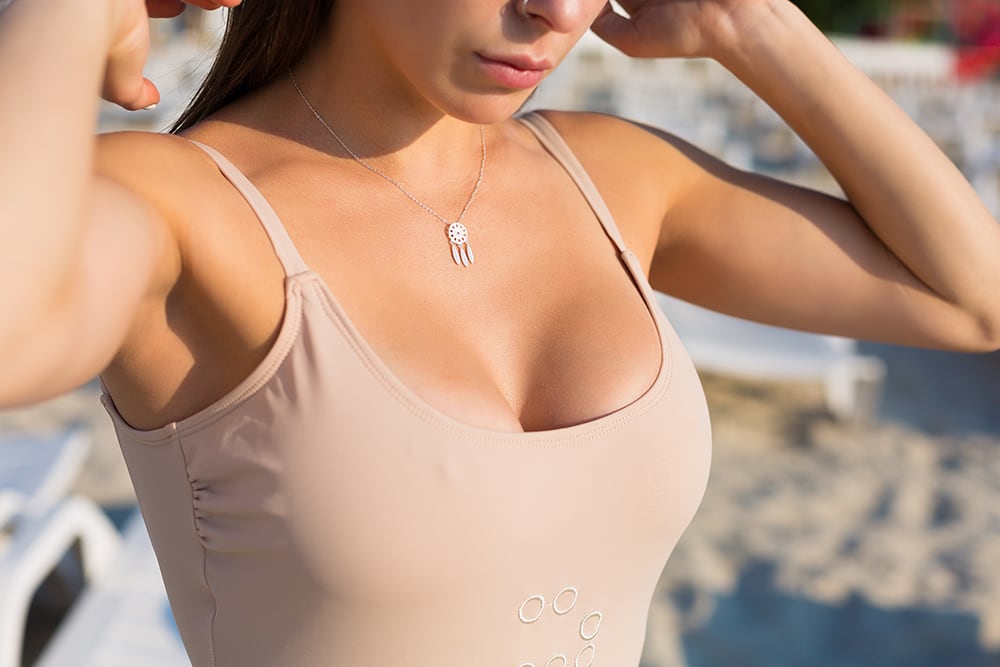Breast Reduction
Many women suffer from symptoms caused by heavy breasts that make some day-to-day activities intolerable. Women will often turn to breast reduction surgery to feel more confident and comfortable in their own skin in addition to seeking relief from their symptoms. A breast reduction involves removing excess fat, breast tissue, and skin to alleviate discomfort and achieve a more proportional breast shape. Unlike breast augmentation, which increases breast size using implants, reduction aims to decrease breast volume. Most often, it will also involve a breast lift, which raises and firms the breasts by removing surplus skin, tightening the surrounding tissue, and elevating the breasts onto the ribcage. This helps to better support the breast tissue and offload tension on the neck and shoulders. Causes of heavy breasts and sagging (or breast ptosis) can include genetic factors, post-partum changes, hormonal changes, weight fluctuations, and the natural aging process.
At Brighter Day Cosmetic and Reconstructive Surgery, board-certified plastic surgeon Kevin Day, MD is experienced with a wide range of advanced breast surgery options, including breast reduction. Dr. Day understands the positive impact this procedure can have on his patients’ day-to-day lives, and he is dedicated to providing customized treatment plans and a safe, welcoming environment for individuals who are considering breast reduction.
Explore Topics On This Page
What Is Breast Reduction?
Breast reduction is a surgical procedure designed to reduce the size and shape of a woman’s breasts when they are too large or heavy for their body type. Along with the removal of excess tissue, the surgery also includes reshaping and elevating the breasts to create a more proportional physique. While a breast reduction has many aesthetic benefits, the procedure is known best for its functional improvements and ability to enhance a patient’s daily comfort and quality of life.
Breast reduction patients are often:
- Suffering from neck, shoulder, and back pain
- Experiencing skin irritation and chafing due to sweat trapped in the breast crease
- Left with grooves in their skin from their bra straps
- Suffering from numbness in the arms and/or hands
- Struggling to find clothes that fit them appropriately
- Unable to properly and comfortably exercise
- Dissatisfied with their appearance due to breasts that are too large and/or heavy for their bodies
What Does the Breast Reduction Procedure Involve?
Breast reduction involves the surgical removal of excess breast fat, glandular tissue, and/or skin to achieve a breast size in proportion with the body, as well as to alleviate discomfort associated with overly large breasts. The outpatient procedure typically begins with the administration of anesthesia. Incisions are then made, commonly around the areola and down the breast, and the excess tissue and skin are removed. The remaining tissue is reshaped and lifted, the skin is repositioned, and the nipples and areolas are placed appropriately. The incisions are then closed.

What Can I Expect in My Breast Reduction Recovery?
During breast reduction recovery, patients will typically experience some soreness, swelling, and bruising. Those side effects should subside gradually over time. A supportive post-surgical bra should be worn to help promote a comfortable and safe healing process. Pain medication can help manage possible discomfort. While most patients return to their regular routines after a couple of weeks, rigorous activities should be avoided for at least a month. It is important that patients attend follow-up appointments to monitor the recovery progress.
What Will My Breast Reduction Scars Look
The appearance of breast reduction scars will be determined by the incision technique used during the procedure. The most common techniques are:
- Periareolar – The periareolar technique can be used in select cases and involves an incision made around the areola. It is sometimes referred to as the “donut” method. This option may not be ideal for patients with severe ptosis.
- Vertical – Also known as the “lollipop” technique, the vertical incision approach includes going around the edges of the areola and down the breast crease. The vertical method is often suitable for patients with moderately large breasts and without excess breast skin or significant breast ptosis.
- Inverted T – The inverted T technique, or “anchor” option, consists of an incision made around the areola and down the breast, with an additional incision made along the breast crease. This method is preferable for patients needing a significant reduction and is the most commonly utilized technique.
Although some level of scarring is inevitable with breast reduction surgery, Dr. Day takes great care to minimize the visibility of residual scars as much as possible.
How Much Does Breast Reduction Cost?
Breast reduction surgery is typically covered by insurance if the symptoms are severe and conservative treatments such as physical therapy, behavior modification, localized skin care, massage therapy, or acupuncture have failed to provide relief. In cases where insurance coverage is denied, the cost of a breast reduction may vary from patient to patient as treatment plans are tailored to a patient’s specific needs and aesthetic goals. For non-insurance cases, the procedure price may range from $10,000 to $14,000. Factors that can contribute to the overall cost include:
- Surgeon’s fees
- Anesthesia fees
- Post-surgical garments
- Prescribed medication
During a consultation with Dr. Day, a treatment plan will be developed and then the customized cost will be provided by a member of our team.
For more information on breast reduction surgery or to schedule a consultation, please contact our office today.
